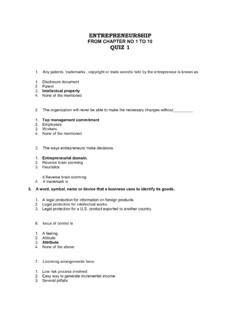Transcription of The Section 179 and Section 168(k) Expensing Allowances ...
1 The Section 179 and Section 168(k) Expensing Allowances : Current Law and Economic Effects Gary Guenther Analyst in Public Finance May 1, 2018 Congressional Research Service 7-5700 RL31852 Section 179 and Bonus Depreciation Expensing Allowances Congressional Research Service Summary Expensing is the most accelerated form of depreciation. Section 179 of the Internal Revenue Code allows a taxpayer to expense (or deduct as a current rather than a capital expense) up to $1 million of the total cost of new and used qualified depreciable assets it buys and places in service in 2018, within certain limits.
2 Firms unable to claim this allowance may recover the cost of qualified assets over longer periods, using the depreciation schedules from Sections 167 or 168. While the Section 179 Expensing allowance is not expressly targeted at smaller firms, the limits on its use effectively tend to confine its benefits to such firms. Section 168(k) allows taxpayers to expense 100% of the cost of qualified assets bought and placed in service between September 28, 2017, and December 31, 2022. There is considerable overlap between the property eligible for the Section 179 and Section 168(k) Expensing Allowances .
3 Since 2002, the two Allowances have been used primarily as tax incentives for stimulating the economy. Several studies have assessed the economic effects of the 30% and 50% bonus depreciation Allowances from 2002 to 2004 and from 2008 to 2010. Their findings suggested that accelerated depreciation did affect investment in qualified assets, but that it was a relatively ineffective tool for stimulating the economy during periods of weak or negative growth. Available evidence also suggests that the Expensing Allowances have a moderate effect at best on the level and composition of business investment and its allocation among industries, the distribution of the federal tax burden among different income groups, and the cost of tax compliance for smaller firms.
4 The Allowances of course have advantages and disadvantages. On the one hand, an Expensing allowance simplifies tax accounting, and a temporary allowance has the potential to stimulate increased business investment in favored assets in the short run by reducing the user cost of capital, increasing the cash flow of investing firms, and giving firms an incentive to make qualifying investments before the incentive expires. On the other hand, an Expensing allowance is likely to interfere with an efficient allocation of capital among investment opportunities by diverting capital away from more productive uses with relatively low after-tax returns.
5 In December 2017, the House and the Senate agreed on a measure ( 1, 115-97) to revise key parts of the federal tax code. The new tax law made significant changes to both Section 179 and Section 168(k). In the case of the Section 179 Expensing allowance, 115-97 permanently raised the maximum allowance to $1 million, and the phaseout threshold for the allowance to $ million, beginning in 2018; it also indexed both amounts for inflation starting in 2019. The act also expanded the definition of qualified property to include qualified improvement property, specified improvements ( , new roofs and heating systems) to nonresidential real property, and property used in connection with lodging.
6 In another change, the $25,000 Expensing limit for heavy-duty sport utility vehicles imposed in 2003 was indexed for inflation starting in 2019. In the case of the bonus depreciation allowance, 115-97 increased it to 100% for qualified property acquired and placed in service between September 28, 2017, and December 31, 2022; the allowance is scheduled to phase out to 0% starting in 2027. In addition, the placed-in-service deadlines for property with relatively long production periods and for noncommercial aircraft were set one year longer.
7 The wording of the final bill led to the unintended result that qualified improvement property became ineligible for bonus depreciation, as it no longer had a 15-year recovery period. As things now stand, such property is treated as 39-year nonresidential real property, unless Congress alters the language. Section 179 and Bonus Depreciation Expensing Allowances Congressional Research Service Contents Introduction .. 1 Current Expensing Allowances .. 1 Section 179 .. 1 Maximum Expensing Allowance .. 1 Qualified Property.
8 1 Limitations on Use of the Section 179 Allowance .. 2 Claiming the Allowance .. 3 Bonus Depreciation Allowance .. 3 Option to Exchange the BDA for Unused Credits .. 4 Interaction with Other Depreciation Allowances , Including the Section 179 Allowance .. 5 Legislative History of the Two Expensing Allowances .. 5 Section 179 .. 5 Bonus Depreciation Allowance .. 8 Economic Effects of the Section 179 and Bonus Depreciation Allowances .. 9 Accelerated Depreciation as a Policy Tool for Economic Stimulus .. 10 Efficiency Effects.
9 14 Equity Effects .. 17 Tax Administration .. 18 Tables Table 1. Maximum Expensing Allowance and Investment Limitation from 1987 to 2018 .. 2 Contacts Author Contact Information .. 19 Section 179 and Bonus Depreciation Expensing Allowances Congressional Research Service 1 Introduction Under current tax law, firms may expense (or deduct as a current rather than a capital expense) up to $1 million of the total cost of new and used qualified assets they purchase and place in service in tax years beginning in 2018 under Section 179 of the federal tax code.
10 They also have the option under Section 168(k) of Expensing the entire cost of qualified assets they acquire and place in service between September 28, 2017, and December 31, 2022. Many of the assets that qualify for the Section 179 Expensing allowance are also eligible for the Section 168(k) Expensing allowance (which is also known as bonus depreciation). Expensing is the most accelerated form of depreciation. It has the potential to stimulate business investment by reducing the cost of capital for favored investments and by increasing the cash flow of firms undertaking such investments.













